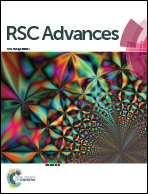Ag-catalyzed diastereoselective [6 + 3] cycloaddition of tropone with homoserine lactone-derived azomethine ylides: synthesis of tricyclic spiropiperidines†
Abstract
Ag-catalyzed [6 + 3] cycloaddition of tropone with homoserine lactone derived azomethine ylides has been developed. The reaction works efficiently under mild conditions to give tricyclic spiropiperidines in moderate to excellent yields with excellent diastereoselectivities.
![Graphical abstract: Ag-catalyzed diastereoselective [6 + 3] cycloaddition of tropone with homoserine lactone-derived azomethine ylides: synthesis of tricyclic spiropiperidines](/en/Image/Get?imageInfo.ImageType=GA&imageInfo.ImageIdentifier.ManuscriptID=C6RA14018A&imageInfo.ImageIdentifier.Year=2016)

 Please wait while we load your content...
Please wait while we load your content...